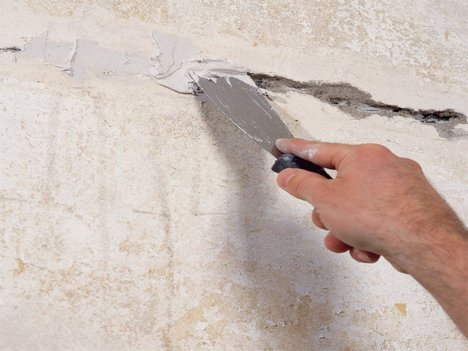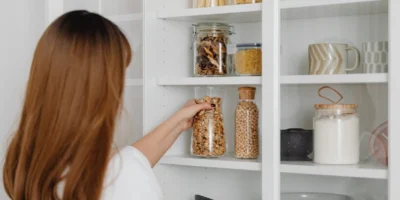When refurbishing, the preparation is crucial for a good result. This includes, first of all, to close holes and cracks in the walls. The problem: Which filler is the right one for which purpose and how do you do it? Here are some tips to choose and use the right filler.
Some self-helpers have already brought to the verge of despair: As soon as the wallpaper was removed from the walls , revealed a picture of small craters, cracks and dowel holes in the plaster of the wall. A condition that is far removed from the smooth, or wallpaperable wall and usually more effort than you thought before.
Although today fine hairline cracks can be easily laminated with the proven non-woven wallpapers, larger plaster damage and old dowel holes must be repaired quite conventionally with trowels and putty .
Repair Walls: This tool makes work easier
All you need is a small tool kit that includes a set of spatula, a small chisel, and a medium hammer next to a soft plaster cup. In case of severe cracks you still need a tear tape and if possible a so-called smoothing trowel.
Depending on the extent of the damage, you can choose between finished putties for minor repairs and those in powder form, which you mix yourself when you choose and use the right filler. Their advantage is clearly in the price, which is well below that of ready-to-use fillers when you choose and use the right filler. However, some ready-to-use products contain solvents that allow for surface work only in well-ventilated areas.
Choose and use the right filler: What is putty made from?
All common fillers are made on a gypsum basis . However, since gypsum has the property of fast hardening, products which are not commercially available as construction or electric gypsum are added with retarders, fibers and other substances which prolong the working life and, for example, prevent shrinkage. This also explains the higher price compared to simple building plaster and the term putty.
Smooth walls clean: tips and tricks
Eliminate drilled holes with dowels : The number one problem is drilled holes that contain dowels that are no longer needed. You must before closing the borehole are generally removed so that the filler can be pressed as deeply as possible into the well.
Remove cracks of the wall: Problem number two are cracks. They have many different causes, which must be clarified before renovation. Cracks that have static causes are issues that need to be taken care of when renting the landlord and a professional. Cracks that are taken care of while renovating are almost always cracks. The cause may be impacts between different materials in the wall, at the joint cracks form. The reason is different stretching behavior of the materials, which then leads to tensions in the plaster.
Plastering the cable slots : The number three issue are cable slots that the electrician leaves behind when cables are subsequently laid under plaster . No matter whether it is a jetty or a jacket cable, nails or plumps of dried electrical plaster usually protrude over the wall surface in some places. These bumps must first be brought below wall level before closing the slots. Hitting or removing nails as far as possible, carefully remove plaster with a hammer and chisel.
Removing dowels from the wall : While in the last two cases you only have to decide on a suitable filler, you first have a problem with dowel holes – getting the old dowel out of the wall. Here are the most different methods. An old “home remedy” is to try with a corkscrew to pull the dowel out of the wall. This is only possible if the spindle of the corkscrew is sharp-edged and cuts into the dowel.
Choose and use the right filler: next steps
After the preliminary work you fill in cracks and holes and your wall is ready for the new wallpaper.
First comes water in the plaster cup – never vice versa! – And about one third of the filling level, otherwise the cup is too full to touch the gypsum blob-free.
Old dowels, which are no longer needed after renovation, must first be removed. This is best done with a thick, self-cutting wood screw and a powerful pliers, ideal is a so-called grip pliers.Always screw in the screw by hand as far as possible.
The adjacent plaster is first thoroughly wetted with a sponge. This causes the gypsum or putty not quickly moisture is removed, which can lead to poor adhesion and cracking. Especially important if the plaster was removed with the chisel and chipped off irregularly.
Fine cracks in the plaster (here a typical stress crack) can be quickly and easily closed with a grout. Usually acrylic or acrylic, these compounds have the advantage of being paintable. They are simply pressed directly from the cartridge or tube into the sucked, dry crack when you choose and use the right filler.
Deep cracks you have to go to the bottom of the repair and choose and use the right filler. The crack is opened with the hammer and a pointed chisel up to the masonry and extended slightly. This creates more adhesive surface for the putty
Those who opt for normal plaster can extend the processing time (so-called pot life) by adding white glue (wood glue) something. It is enough already about a tablespoon size on a plaster cup. Specialists mix so-called rabbit glue from specialist retailers in the ratio 1:12 with water and then stir in the plaster.
Common fillers for all cases: advantages and disadvantages
Alabaster
- Advantages: very cheap, for filling and smoothing
- Disadvantages: binds fast
Filler powder
- Advantages: long processing time, easy to handle, also as granules
- Disadvantages: more expensive than building plaster
Finish Filler
- Advantages: ready to use, ideal for small repairs
- Disadvantages: expensive, some products contain solvents
Finished spatula in tubes
- Advantages: ideal for filling dowel holes and small damages
- Disadvantages: only for a few, special applications, some with solvents
Grout
- Advantages: immediately applicable, – ideal for quick repair of small cracks
- Disadvantages: bad grip for new dowels, – hard to smooth
 Gerhardt Richter is a writer and a trainer at trade technical colleges, specializing in carpentry, plumbing, mechanics and construction.
Gerhardt Richter is a writer and a trainer at trade technical colleges, specializing in carpentry, plumbing, mechanics and construction.




